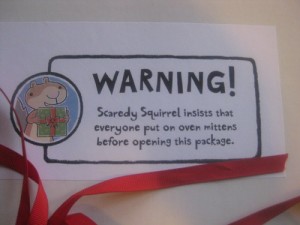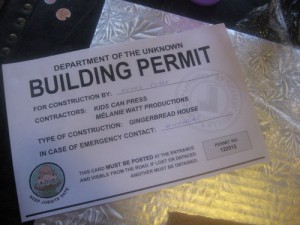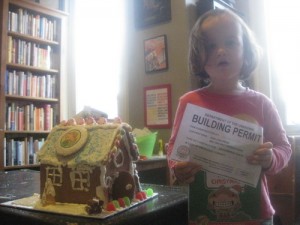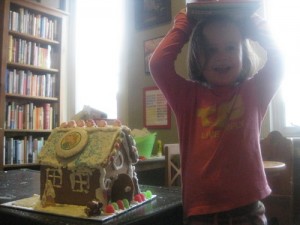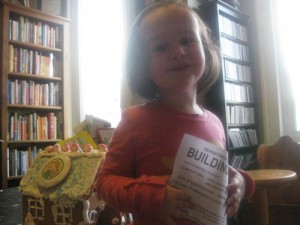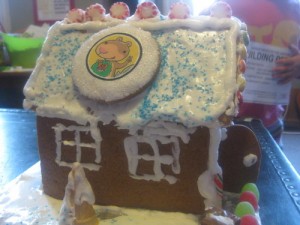December 10, 2012
"THEY… USED… TO… READ! They'd READ and READ."
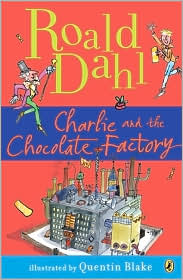 The most important thing we’ve learned,
The most important thing we’ve learned,
So far as children are concerned,
Is never, NEVER, NEVER let
Them near your television set —
Or better still, just don’t install
The idiotic thing at all.
In almost every house we’ve been,
We’ve watched them gaping at the screen.
They loll and slop and lounge about,
And stare until their eyes pop out.
(Last week in someone’s place we saw
A dozen eyeballs on the floor.)
They sit and stare and stare and sit
Until they’re hypnotised by it,
Until they’re absolutely drunk
With all that shocking ghastly junk.
Oh yes, we know it keeps them still,
They don’t climb out the window sill,
They never fight or kick or punch,
They leave you free to cook the lunch
And wash the dishes in the sink —
But did you ever stop to think,
To wonder just exactly what
This does to your beloved tot?
IT ROTS THE SENSE IN THE HEAD!
IT KILLS IMAGINATION DEAD!
IT CLOGS AND CLUTTERS UP THE MIND!
IT MAKES A CHILD SO DULL AND BLIND
HE CAN NO LONGER UNDERSTAND
A FANTASY, A FAIRYLAND!
HIS BRAIN BECOMES AS SOFT AS CHEESE!
HIS POWERS OF THINKING RUST AND FREEZE!
HE CANNOT THINK — HE ONLY SEES!
‘All right!’ you’ll cry. ‘All right!’ you’ll say,
‘But if we take the set away,
What shall we do to entertain
Our darling children? Please explain!’
We’ll answer this by asking you,
‘What used the darling ones to do?
‘How used they keep themselves contented
Before this monster was invented?’
Have you forgotten? Don’t you know?
We’ll say it very loud and slow:
THEY… USED… TO… READ! They’d READ and READ,
AND READ and READ, and then proceed
To READ some more. Great Scott! Gadzooks!
One half their lives was reading books!
The nursery shelves held books galore!
Books cluttered up the nursery floor!
And in the bedroom, by the bed,
More books were waiting to be read!
Such wondrous, fine, fantastic tales
Of dragons, gypsies, queens, and whales
And treasure isles, and distant shores
Where smugglers rowed with muffled oars,
And pirates wearing purple pants,
And sailing ships and elephants,
And cannibals crouching ’round the pot,
Stirring away at something hot.
(It smells so good, what can it be?
Good gracious, it’s Penelope.)
The younger ones had Beatrix Potter
With Mr. Tod, the dirty rotter,
And Squirrel Nutkin, Pigling Bland,
And Mrs. Tiggy-Winkle and-
Just How The Camel Got His Hump,
And How the Monkey Lost His Rump,
And Mr. Toad, and bless my soul,
There’s Mr. Rat and Mr. Mole-
Oh, books, what books they used to know,
Those children living long ago!
So please, oh please, we beg, we pray,
Go throw your TV set away,
And in its place you can install
A lovely bookshelf on the wall.
Then fill the shelves with lots of books,
Ignoring all the dirty looks,
The screams and yells, the bites and kicks,
And children hitting you with sticks-
Fear not, because we promise you
That, in about a week or two
Of having nothing else to do,
They’ll now begin to feel the need
Of having something to read.
And once they start — oh boy, oh boy!
You watch the slowly growing joy
That fills their hearts. They’ll grow so keen
They’ll wonder what they’d ever seen
In that ridiculous machine,
That nauseating, foul, unclean,
Repulsive television screen!
And later, each and every kid
Will love you more for what you did.
-Roald Dahl, from Charlie and the Chocolate Factory
December 4, 2012
Christmas Reads: The Jolly Christmas Postman
 At the beginning of November, when I too was moaning about “the Christmas creep”, I forgot to bat an eye when I came across The Jolly Christmas Postman in the bookshop, and instead partook in an elaborate jig in my head and bought the book immediately. Because we’re big fans of the Ahlbergs at our house, and of the Jolly Postman in his original form, and the postal system in general. I saved the book until December 1 and we’ve been reading it steadily ever since. And how wonderful it is that this book isn’t riding the tails of its franchise, but instead is even better, richer than the original. We’re totally in love with it.
At the beginning of November, when I too was moaning about “the Christmas creep”, I forgot to bat an eye when I came across The Jolly Christmas Postman in the bookshop, and instead partook in an elaborate jig in my head and bought the book immediately. Because we’re big fans of the Ahlbergs at our house, and of the Jolly Postman in his original form, and the postal system in general. I saved the book until December 1 and we’ve been reading it steadily ever since. And how wonderful it is that this book isn’t riding the tails of its franchise, but instead is even better, richer than the original. We’re totally in love with it.
There is so much detail here, right down to the postmarks (from such places as Banbury Cross and Wobbleton, and if you’re as entrenched in Mother Goose as we are, you too will find this delightful). Allusions to the lady with the alligator purse, a glimpse into Red Riding Hood’s playhouse, updates on our favourite characters (The 3 Bears have become a 4some, Baby Bear now a big brother!). And it’s not jus’t letters our Jolly Postman is delivering; along with Christmas cards, his envelopes contain a jigsaw puzzle, a board game, and an elaborate 3D card. A present full of presents indeed.
Oh, and I love the meta elements! “‘A book in a book!’ says the Gingerbread Boy./ “What a simply delicious surprise.”/ (But if he only knew he’s in one too–/That would really open his eyes.)’ The first two lines of which are basically my literary philosophy.
The Jolly Postman’s route ends up at the North Pole at a certain workshop where he’s dropping off a huge pile of children’s letters. And fortunately, because it’s dark, snowy and cold, he’s able to hitch a ride on Santa’s sleigh to get home.
November 21, 2012
Scaredy Squirrel Gingerbread House (with a Building Permit)
Of everything we’ve ever received in the mail, the Scaredy Squirrel gingerbread house certainly takes the cake. It’s not just any gingerbread house kit, you see, because it comes with a building permit, and special instructions by Scaredy Squirrel on building the house right to code. Further, the gingerbread is completely delicious and has filled our entire house with the redolence of Christmas (already). Perhaps reminding us that there are only 30-some days left in which to come prepared for the holiday, and in accordance, we’ve also been equipped with the brand new Scaredy Squirrel book, Scaredy Squirrel Prepares for Christmas. With instructions to wear a hockey helmet (in case of falling ornaments), and to avoid candy canes (might shatter!!!).
The kit arrived yesterday, and Harriet insisted that we build it while her little friend Iole was visiting. It occurred to me at this point that 3 year-olds are far better are being agents of destruction than construction, and so this might be a terrible idea. It also made it quite possible that I’d end up swearing at Harriet in front of Iole’s mother.
Fortunately, the girls were very helpful, and we did the windows, and put the walls and roof up. I figured the instructions to wait overnight before decorating were only optional and we got started on that too, but then the house collapsed in on itself over and over again and I realized that maybe Scaredy Squirrel knew what he was talking about with his instructions. So we let the house dry, and Harriet finished decorating it this afternoon. We love it, and don’t know how long we can wait before we eat it– that smell! And the best thing is that I didn’t even swear once.
November 15, 2012
Virginia Lee Burton: A Sense of Place
One day when I finally get my act together, I will write an enormous blog post about how this summer we ended up buying every single book Virginia Lee Burton ever wrote. The entire Virginia Lee Burton library, which now lives on a shelf in the living room, rather than in Harriet’s room with the other kids’ books. Harriet adores them all, and they mean a whole lot to all of us, actually. I read Burton’s biography last year, and it only increased my appreciation for her work, for her genius. To learn how important she considered book design to be, how innovative she was as an illustrator, the extraordinary praise her sons had for her as an artist and as a mother, the richness of her life, and her vision. I learned that beyond her books, Burton was also a well-known textile designer, founder of the Folly Cove Designers artistic community. She was brilliant, and her work is timeless, and her ideas have influenced the way I’ve come to understand the world, and my relationship to my child.
So in all my enthusiasm, I was pleased to discover a 2008 PBS documentary about Burton called Virginia Lee Burton: A Sense of Place. Stuart and I borrowed it from the library and sat down to watch it last weekend, and while much of the material was familiar to me from the biography (whose author acted as a consultant for the film), I enjoyed the movie very much. Interviews with Burton’s sons, friends and fellow-artists, and even Dickie Birkenbush himself! Other interviews with children’s authors, librarians, academics and artists provided great context to Burton’s story and underlined her singularity.
I don’t know that I’d ever paid attention to Burton’s books’ feminist angle. She wrote with her sons as her intended audience so that her subject matter is decidedly “boyish” (not that it stops my girl!)–a train, a steam shovel, a snow plow, a cable car, a horse in a Western. But all her subjects–the train, the steam shovel, the snow plow, the cable car, the house and even the Little House herself–are charactertized as female. The female characters are equal partners with male characters, independent, strong and hard-working. Which provides me with a whole new level of appreciation for these books, though it’s not as though I needed one…
See also: “What Sally Draper must have been reading: Virginia Lee Burton and Mad Men”
More details about the doc are here.
November 13, 2012
Where Are the Parents? 8 Excellent Books about Inattentive Moms and Dads
(Exciting note! This is my first cross-post to the excellent Bunch Family site. Hope you enjoy, and check out the scene there as well.)
They are useful, books about inattentive moms and dads. They prepare children for independence and allude to parents having their own complexities and places in the world beyond the family. A parent-free universe also paves the way for marvelous fictional adventures.
 Sunday Morning was created by kid-lit royalty, Judith Viorst of Alexander and the No Good Very Bad Day and Hilary Knight, who drew Eloise. Fantastic silhouette drawings show Mom and Dad stumbling home after midnight, re-tucking the kids into bed and making them promise not to make a peep until 9:45 am (“and we’ll tell you when that is”). The rest of the story is about the kids creating havoc in attempts to entertain themselves, (“We colour. We paste. We build a tower higher than my bed”) with a parent calling out from the bedroom, “Some boys are going to be spanked” every few pages. It’s a story of sibling tension, imagination, fun, and the happy ending of well rested parents.
Sunday Morning was created by kid-lit royalty, Judith Viorst of Alexander and the No Good Very Bad Day and Hilary Knight, who drew Eloise. Fantastic silhouette drawings show Mom and Dad stumbling home after midnight, re-tucking the kids into bed and making them promise not to make a peep until 9:45 am (“and we’ll tell you when that is”). The rest of the story is about the kids creating havoc in attempts to entertain themselves, (“We colour. We paste. We build a tower higher than my bed”) with a parent calling out from the bedroom, “Some boys are going to be spanked” every few pages. It’s a story of sibling tension, imagination, fun, and the happy ending of well rested parents.
 In Alfie’s Feet, by the wondrous Shirley Hughes, the parents are attentive enough, usually frazzled actually and totally on top of the shoe shopping, but I always like that in Shirley Hughes’ books, Mum and Dad are seen relaxing with obligatory cups of tea. Further, when Dad takes Alfie to the park to try out his new rain-boots, Dad takes not only his book along with him but also his newspaper. Alfie is shown splashing happily in the puddles while Dad reads on the periphery, comfortably parked on a bench.
In Alfie’s Feet, by the wondrous Shirley Hughes, the parents are attentive enough, usually frazzled actually and totally on top of the shoe shopping, but I always like that in Shirley Hughes’ books, Mum and Dad are seen relaxing with obligatory cups of tea. Further, when Dad takes Alfie to the park to try out his new rain-boots, Dad takes not only his book along with him but also his newspaper. Alfie is shown splashing happily in the puddles while Dad reads on the periphery, comfortably parked on a bench.
 Things take a more sinister turn in “Disobedience” by A.A. Milne, a poem from his collection When We Were Very Young. Most of the fun of this one lies in the rhythm, and reading aloud:
Things take a more sinister turn in “Disobedience” by A.A. Milne, a poem from his collection When We Were Very Young. Most of the fun of this one lies in the rhythm, and reading aloud:
James James
Morrison Morrison
Weatherby George Dupree
Took great
Care of his Mother,
Though he was only three.
James James Said to his Mother,
“Mother,” he said, said he;
“You must never go down
to the end of the town,
if you don’t go down with me.
Naturally, Mother disobeys and goes to the end of the town anyway, never to return. The poem is useful for the attention it pays to children’s fears of separation from their parents, and also for its mysteries, its strangeness, the questions it leaves unanswered.
 A exuberant, boisterous book, There Were Monkeys in My Kitchen is certainly one that leaves the reader asking, “Where are the parents?” Written by Canadian poet Sheree Fitch and recently re-issued with new illustrations by Sydney Smith, Monkeys is the story a small girl who is left defenceless as her house is overtaken by simian creatures. “I said, ‘This place is CHAOS!’ I said, ‘BABOON catastrophe!’ You folks have got to help! You’ve got to rescue me!” But nobody comes, even though she’s called the police and RCMP. And by the time help arrives, it’s already too late.
A exuberant, boisterous book, There Were Monkeys in My Kitchen is certainly one that leaves the reader asking, “Where are the parents?” Written by Canadian poet Sheree Fitch and recently re-issued with new illustrations by Sydney Smith, Monkeys is the story a small girl who is left defenceless as her house is overtaken by simian creatures. “I said, ‘This place is CHAOS!’ I said, ‘BABOON catastrophe!’ You folks have got to help! You’ve got to rescue me!” But nobody comes, even though she’s called the police and RCMP. And by the time help arrives, it’s already too late.
 Absent parents are a trusting, benevolent force in Caroline Woodward and Julie Morstad’s Singing Away the Dark, which was nominated for all the major Canadian children’s book prizes in 2011. It’s about a six-year-old girl in a rural community who must walk through the darkened woods on winter mornings to get to her school bus stop. In verse, Woodward describes how the girl summons all her courage by trudging forth and singing loud: “I see a line of big old trees, marching up the hill. ‘I salute you, Silent Soldiers! Help me if you will.’” The verse is perfectly complemented by the detail of Morstad’s delightful drawings.
Absent parents are a trusting, benevolent force in Caroline Woodward and Julie Morstad’s Singing Away the Dark, which was nominated for all the major Canadian children’s book prizes in 2011. It’s about a six-year-old girl in a rural community who must walk through the darkened woods on winter mornings to get to her school bus stop. In verse, Woodward describes how the girl summons all her courage by trudging forth and singing loud: “I see a line of big old trees, marching up the hill. ‘I salute you, Silent Soldiers! Help me if you will.’” The verse is perfectly complemented by the detail of Morstad’s delightful drawings.
 Similarly a story of bravey, Maurice Sendak’s Outside Over There is a long way from the wild rumpus of Where the Wild Things Are. “When Papa was away at sea,” it begins, “and Mama in the arbor, Ida played her wonder horn to rock the baby still—but never watched.” Mama is clearly suffering from some kind of depression, and Ida has been left in charge of her baby sister, who is stolen away by goblins when Ida turns her back. It’s a strange, disturbing tale, with simple prose given enormous depth by Sendak’s remarkable illustrations, but small children have an appreciation for questions without answers and they might better understand this book than their parents do. Heroic Ida triumphs in the end, rescuing the baby and bringing her home.
Similarly a story of bravey, Maurice Sendak’s Outside Over There is a long way from the wild rumpus of Where the Wild Things Are. “When Papa was away at sea,” it begins, “and Mama in the arbor, Ida played her wonder horn to rock the baby still—but never watched.” Mama is clearly suffering from some kind of depression, and Ida has been left in charge of her baby sister, who is stolen away by goblins when Ida turns her back. It’s a strange, disturbing tale, with simple prose given enormous depth by Sendak’s remarkable illustrations, but small children have an appreciation for questions without answers and they might better understand this book than their parents do. Heroic Ida triumphs in the end, rescuing the baby and bringing her home.
 The tone is lighter in Mairi Hedderwick’s Katie Morag Delivers the Mail. Katie Morag lives on a tiny island in the Scottish Hebrides, where her mother is the postmistress and her father manages the general store. One day when her parents are particularly busy, Katie Morag is put in charge of delivering the mail. Things go awry when she gets distracted from her task, and the situation is only put right again with the help of Katie Morag’s wily granny. It’s a story about the overwhelming nature of independence, but also the surprising and liberating fact of how much one can get away with in actuality.
The tone is lighter in Mairi Hedderwick’s Katie Morag Delivers the Mail. Katie Morag lives on a tiny island in the Scottish Hebrides, where her mother is the postmistress and her father manages the general store. One day when her parents are particularly busy, Katie Morag is put in charge of delivering the mail. Things go awry when she gets distracted from her task, and the situation is only put right again with the help of Katie Morag’s wily granny. It’s a story about the overwhelming nature of independence, but also the surprising and liberating fact of how much one can get away with in actuality.
 And finally, in Dennis Lee’s Jelly Belly, a collection of poems well-populated with free-range kids and inattentive parents, the mother from “Mrs. Murphy and Mrs. Murphy’s Kids” must be singled out. A modern-day version of the old woman in the shoe, Mrs. Murphy kept her kids in a can of peas but, “The kids got bigger/And the can filled up,/ So she moved them into/ A measuring cup.” The kids move from one vessel into another as they grow, eventually ending up on a mountain top. “But the kids just grew/ And the mountain broke apart,/ And she said, “Darned kids/ They were pesky from the start!” She’s eventually relieved of her duties when the kids grow up and have babies of their own. And we’re told that Mrs. Murphy’s kids kept all their kids in a can of peas, the whole unfortunate cycle beginning again.
And finally, in Dennis Lee’s Jelly Belly, a collection of poems well-populated with free-range kids and inattentive parents, the mother from “Mrs. Murphy and Mrs. Murphy’s Kids” must be singled out. A modern-day version of the old woman in the shoe, Mrs. Murphy kept her kids in a can of peas but, “The kids got bigger/And the can filled up,/ So she moved them into/ A measuring cup.” The kids move from one vessel into another as they grow, eventually ending up on a mountain top. “But the kids just grew/ And the mountain broke apart,/ And she said, “Darned kids/ They were pesky from the start!” She’s eventually relieved of her duties when the kids grow up and have babies of their own. And we’re told that Mrs. Murphy’s kids kept all their kids in a can of peas, the whole unfortunate cycle beginning again.
November 11, 2012
We go to the theatre: Soulpepper's Alligator Pie!
 Yesterday was a monumental day, as we took Harriet to see her very first play. It was Alligator Pie, an original Soulpepper production based on the works of Dennis Lee. We’d been seriously preparing for the experience by reading the book entire, which is beloved by our whole family. It’s just as wonderful as Dennis Lee knew it would be to “discover the imagination playing on things [we] live with every day”, but I suppose it’s not just about the here and now because I really love that with Dennis Lee books, Harriet is enjoying the books that were mine as a child. But yes, I love that we get to read about the streets where we live: “Yonge Street, Bloor Street,/ Queen Street, King: Catch an itchy monkey/With a piece of string.” Walking around the city, we get to see our books brought to life, and that’s an extraordinary experience, the very best way to love literature.
Yesterday was a monumental day, as we took Harriet to see her very first play. It was Alligator Pie, an original Soulpepper production based on the works of Dennis Lee. We’d been seriously preparing for the experience by reading the book entire, which is beloved by our whole family. It’s just as wonderful as Dennis Lee knew it would be to “discover the imagination playing on things [we] live with every day”, but I suppose it’s not just about the here and now because I really love that with Dennis Lee books, Harriet is enjoying the books that were mine as a child. But yes, I love that we get to read about the streets where we live: “Yonge Street, Bloor Street,/ Queen Street, King: Catch an itchy monkey/With a piece of string.” Walking around the city, we get to see our books brought to life, and that’s an extraordinary experience, the very best way to love literature.
 Seeing Alligator Pie on stage took it to a whole new level though. In spite of our prep, much of the show was new to us, based on Dennis Lee poems not just from the books we know (which are Alligator Pie, Garbage Delight and Jelly Belly). And even those pieces we recognized had become otherworldly by being translated into song– “Psychapoo” as a doo-wop ballad, “Tricking” as a rap. The show was loud, and fun–I noted beaming faces in the audience all the around the theatre throughout that were mirroring my own. Its emphasis was on friendship and also on play, not one of the many props on stage ever used for a single purpose of the one you’d imagine it was intended for. The actors (who were also the show’s creators) were full of energy, charisma and talent, and did justice to their material, even made it something new.
Seeing Alligator Pie on stage took it to a whole new level though. In spite of our prep, much of the show was new to us, based on Dennis Lee poems not just from the books we know (which are Alligator Pie, Garbage Delight and Jelly Belly). And even those pieces we recognized had become otherworldly by being translated into song– “Psychapoo” as a doo-wop ballad, “Tricking” as a rap. The show was loud, and fun–I noted beaming faces in the audience all the around the theatre throughout that were mirroring my own. Its emphasis was on friendship and also on play, not one of the many props on stage ever used for a single purpose of the one you’d imagine it was intended for. The actors (who were also the show’s creators) were full of energy, charisma and talent, and did justice to their material, even made it something new.
The show was an hour long, which was the perfect length of time for any audience members who were 3. It was only in the last few minutes when Harriet announced (in a rare moment of silence in the room, of course): “I don’t want to watch this show anymore.” Which was fine, because by then it was over. We got to walk out to the theatre by stomping on a huge sheet of bubble wrap, and all of us were very satisfied with Harriet’s first theatre experience.
We’d even do it again!
November 1, 2012
Kids' book review: I'm Bored
 I was really pleased to review I’m Bored by Michael Ian Black and Debbie Ridpath Ohi in the October issue of Quill & Quire. It’s a funny, thoughtful book that takes the readers somewhere, and the scraggly-haired protagonist is just the kind of spunky girl I like to see in picture books. I also appreciate that it’s a book with a female protagonist that will appeal to boy readers as much as the girls.
I was really pleased to review I’m Bored by Michael Ian Black and Debbie Ridpath Ohi in the October issue of Quill & Quire. It’s a funny, thoughtful book that takes the readers somewhere, and the scraggly-haired protagonist is just the kind of spunky girl I like to see in picture books. I also appreciate that it’s a book with a female protagonist that will appeal to boy readers as much as the girls.
From my review: “Fans of Mo Willems’ Elephant and Piggie series will delight in the latest book by American comedian Michael Ian Black, illustrated by Toronto graphic artist Debbie Ridpath Ohi. Echoing Willems, Black’s story is constructed around the dialogue of an unlikely couple, in this case a small girl and a potato. The text is perfectly complemented by Ohi’s quirky minimalist drawings.”
You can read the rest here.
October 18, 2012
Our Best Book of the Library Haul: The Green Ship by Quentin Blake
 We haven’t had a best book from the library haul in ages, not because the book are no good but because they generally all are, and because life is whirling along at a frenzied pace here so that library books are not what our days hinge about as they once did. But then we picked up Quentin Blake’s The Green Ship from a display at the library about sea and boat books. What a strange, mysterious, magical book about a brother and sister on holiday with an aunt who scramble over a wall to find themselves in a secret garden that is more like a jungle. And in the centre of the garden, they discover a ship except it is not a ship. It’s a strange fixture designed to look like a ship, built from pruned trees, and two tall trees which function as masts. A kind of garden shed is near the front, and inside the brother and sister discover a ship’s wheel, and then they’re discovered themselves.
We haven’t had a best book from the library haul in ages, not because the book are no good but because they generally all are, and because life is whirling along at a frenzied pace here so that library books are not what our days hinge about as they once did. But then we picked up Quentin Blake’s The Green Ship from a display at the library about sea and boat books. What a strange, mysterious, magical book about a brother and sister on holiday with an aunt who scramble over a wall to find themselves in a secret garden that is more like a jungle. And in the centre of the garden, they discover a ship except it is not a ship. It’s a strange fixture designed to look like a ship, built from pruned trees, and two tall trees which function as masts. A kind of garden shed is near the front, and inside the brother and sister discover a ship’s wheel, and then they’re discovered themselves.
They discovered by an older woman and the man she calls Bosun (“boatswain”, and actually he resembles a gardener). Stowaways, the boy and girl are made to scrub the deck, which is really to sweep away leaves, and then they all take tea and have madeira cake. The man and woman are all too happy to have the boy and girl join their crew, and so for the rest of the children’s holiday, they all partake in the ship life together.
I love this book for the same reason I love most of my favourite children’s books: because there is another story going on beneath the surface but we’re not privy to its details. In this video, Blake suggests that the old woman had lost her husband at sea, that he’s the “captain” she references, and that the green ship is a memorial to him. The story is viewed through the children’s eyes only who never stop and wonder at the circumstances around this wondrous thing they’ve found, and I actually like that the woman’s story is left untold. I like that it might not occur to children to wonder why grown-ups do any of the inexplicable things they do.
I loved the story’s climax, when the green ship is taken by a storm and it is though the ship is really a ship at sea as the rain pounds and the wind blows, and the old woman steers the ship and remembers what the Captain would have advised her: “Steer into the eye of the storm”. I have no idea if that’s really good advice, but it’s a line I love, and I imagine that it’s applicable somewhere.
September 30, 2012
Block Letters
 Yesterday we dared to skip nap to attend the Block Letters event at the Lillian H. Smith Library, as part of Culture Days. The show began with Cybele Young reading from her book A Few Blocks, which we’ve been fans of for a while, as well as from Ten Birds, and from her latest book, A Few Bites, which we were happy to purchase for ourselves.
Yesterday we dared to skip nap to attend the Block Letters event at the Lillian H. Smith Library, as part of Culture Days. The show began with Cybele Young reading from her book A Few Blocks, which we’ve been fans of for a while, as well as from Ten Birds, and from her latest book, A Few Bites, which we were happy to purchase for ourselves.
 After the reading, the kids were given a map of the neighbourhood, and we all left the library to go for a walk together. Not just any walk, however. It was an ordinary walk bursting with stories and imagination, similar to the one partaken by Ferdie and Viola in Cybele Young’s books. A little bit of imagination transforms an ordinary walk into an extraordinary adventure. We found a shoe, an empty lake, a strange tower with “Danger No Admittance” on its door. Where did the shoe come from? Why was the lake empty? What was inside the tower? (For the last, the kids came up with a hypothesis involving diamonds, a princess and the British King.)
After the reading, the kids were given a map of the neighbourhood, and we all left the library to go for a walk together. Not just any walk, however. It was an ordinary walk bursting with stories and imagination, similar to the one partaken by Ferdie and Viola in Cybele Young’s books. A little bit of imagination transforms an ordinary walk into an extraordinary adventure. We found a shoe, an empty lake, a strange tower with “Danger No Admittance” on its door. Where did the shoe come from? Why was the lake empty? What was inside the tower? (For the last, the kids came up with a hypothesis involving diamonds, a princess and the British King.)
We explored the alleys and strange pathways of the UofT campus, wondered where all the big rocks along Huron Street had come from, found a secret forest whose trees were sleeping monsters (who turned into rhinos if awakened), and began noticing small, wonderful things we might not have paid attention to before. What’s going on down in the sewer? The sound of streetcars passing? We discovered that everywhere is steeped in wonderment in you only stretch your mind enough to note it.
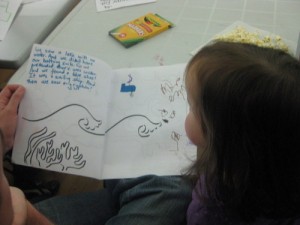 Returning to the library (its own wondrous destination, with gryphons guarding its doorway), kids were equipped with markers and crayons, plus their own storybook with Cybele Young’s drawings inside and enough blank spaces for them to collaborate and tell their own stories of neighbourhood walk. Harriet dictated her tale, and drew some scrawly pictures in Harriet styly. Stuart and I helped her out so it became a bit of a family project.
Returning to the library (its own wondrous destination, with gryphons guarding its doorway), kids were equipped with markers and crayons, plus their own storybook with Cybele Young’s drawings inside and enough blank spaces for them to collaborate and tell their own stories of neighbourhood walk. Harriet dictated her tale, and drew some scrawly pictures in Harriet styly. Stuart and I helped her out so it became a bit of a family project.
There was popcorn, fun and plenty of inspiration. More than anyone could ask for from a Saturday afternoon.
September 18, 2012
Mr. King's Things by Genevieve Cote
 I cannot really claim any objectivity in my adoration of Genevieve Cote’s new book Mr. King’s Things, because a character in it was named after my daughter, which is certainly some kind of conflict of interest. I met Genevieve in 2008 on a rather glorious adventure, and we’ve kept in touch ever since, our bond cemented over a mutual love of teapots (she puts them in all her books!) and my admiration for her work. I was 4 months pregnant with Harriet when she signed me a copy of What Elephant?, and since then, Genevieve’s books have made up a beloved corner of our library: her companion books Me and You and Without You, and also The Lady of Shalott. And we’re especially in love with Mr. King’s Things, which arrived in our mailbox yesterday, dedicated, “For the REAL Harriet.”
I cannot really claim any objectivity in my adoration of Genevieve Cote’s new book Mr. King’s Things, because a character in it was named after my daughter, which is certainly some kind of conflict of interest. I met Genevieve in 2008 on a rather glorious adventure, and we’ve kept in touch ever since, our bond cemented over a mutual love of teapots (she puts them in all her books!) and my admiration for her work. I was 4 months pregnant with Harriet when she signed me a copy of What Elephant?, and since then, Genevieve’s books have made up a beloved corner of our library: her companion books Me and You and Without You, and also The Lady of Shalott. And we’re especially in love with Mr. King’s Things, which arrived in our mailbox yesterday, dedicated, “For the REAL Harriet.”
Mr. King is a cat (with a crown) who is fond of buying stuff. When he returns from his shopping excusions, laden with bags and bags of price-tagged goods, he gets rid of his old things by throwing them into a nearby pond. Gone for good, he supposes, but then one day his things return to haunt him in a terrifying way. With the help of his friends (including a small pink owl called Harriet who goes surfing on a paint pallette), Mr. King realizes the error of his ways and learns how old things can be made new.
This book particularly delights me as it contains the line, ‘”A jumble sale!” cries Harriet. “I love jumble sales!”‘ I am not sure that Genevieve deliberately placed a Barbara Pym reference in her picture book, though with the thing she has for teapots, it might not entirely surprise me.
Harriet seems to not think it so remarkable that a character in a book has been named after her, though when you’re 3 years-old, you’re pretty much blase about everything that isn’t a firetruck. Harriet loves the book though, and I’ve read it over and over. Genevieve Cote’s work is as enchanting as ever.
